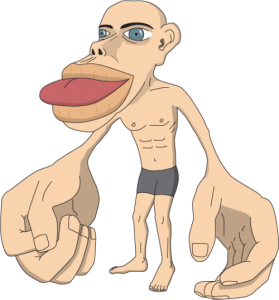How a Weak Grip Helps
The body is a pretty amazing machine. And the more I learn about it and figure out what it can do the more amazed I am.
One of the more interesting things, imo, is that we have built-in governers. You know what I mean by a governer, right? If you've ever driven a golf cart down a hill you're familiar how the speed is controlled when you descend a hill. This is in place for safety and to prevent tipping or crashing the cart.
So what kind of governers does your body have?
Well in our hands and specifically the finger tips we have more nerve endings than any other part of the body except for the mouth and lips.
If we drew a self portrait emphasizing the areas with higher concentrations of nerve endings it might look something like this.
[caption id="attachment_5008" align="aligncenter" width="279"] We learn a lot about our environment through our hands and mouth.
Think about a newborn baby and how they learn about this new world. If they can grab something they will. And once they've gotten ahold of it it's going in their mouth.
And while this can be a good way to learn and explore it can also be our early warning system if something is potentially dangerous to us. If we touch a hot element we flex in order to retract and pull away. And when we taste something awful we usually will spit it out.
So how does this relate to training?
Well imagine doing deadlifts. If someone were to injure themselves it would most likely be a back injury.
Now if the load on the bar was more than our nervous system felt it could handle it would want some kind of an out. Because when you think about it grip strength is indicative of overall strength, isn't it? I don't think I've ever met someone with meat hooks for hands and wasn't an intimidating presence. I'm thinking of some of the heavyweight NHL guys we've trained in the past. Or some of the manual labourers we've had as clients. These guys have massive, strong hands and can handle themselves in a hockey tilt or laying brick for a day.
When we're doing a deadlift our hands are wrapped around the bar. If we don't have the strength, whether it be grip, hips, hamstrings, low back or core, our grip will normally give out before complete a rep.
I'm not sure if there are statistics on this type of thing but I would guess that injuries are higher among those that wrap their hands around the bar. When the nervous system senses a lack of strength it wants the hands to open the grip and release the bar. However when we're strapped in to the bar we can push past limitations in the lift where we normally shouldn't push through.
In addition to not being an advocate of using wraps for deadlifts the next thing to watch for is alternating your grip. Now only can this lead to imbalances as one hand is pronated and one is supinated it also increases the potential for injury such as a tearing a biceps.
[caption id="attachment_5009" align="aligncenter" width="300"] Be careful when using a mixed grip due to the high load on the biceps of the supinated hand.
Be careful when using a mixed grip due to the high load on the biceps of the supinated hand.
The moral of the story is to train your grip strength. And when your grip fails it could be to protect another area of the body that can't handle the load. We don't want to have a weak grip but don't mask it by using lifting straps. And be careful and sporadic when using a mixed grip as picture above.
When you subscribe to the blog, we will send you an e-mail when there are new updates on the site so you wouldn't miss them.

Comments